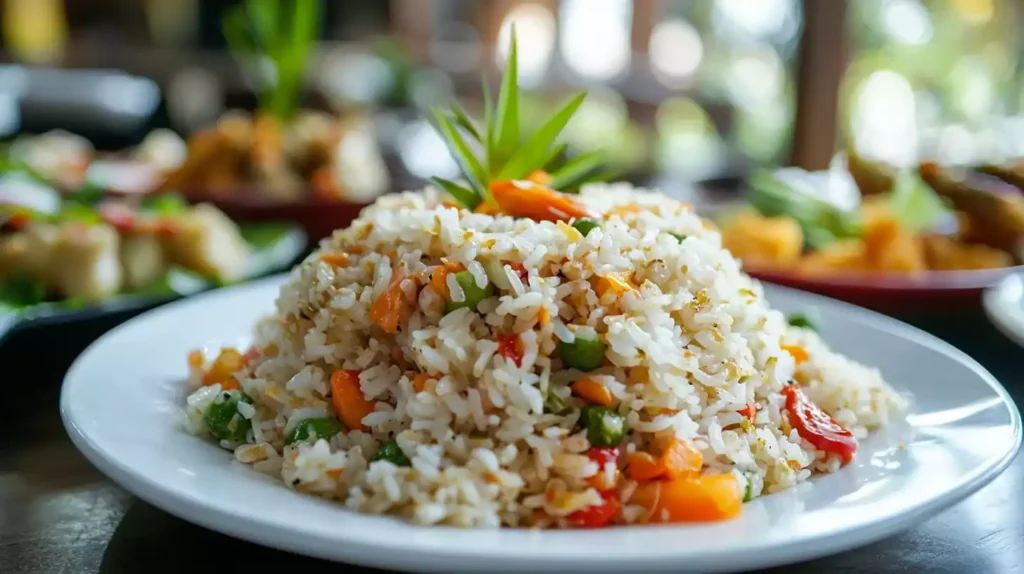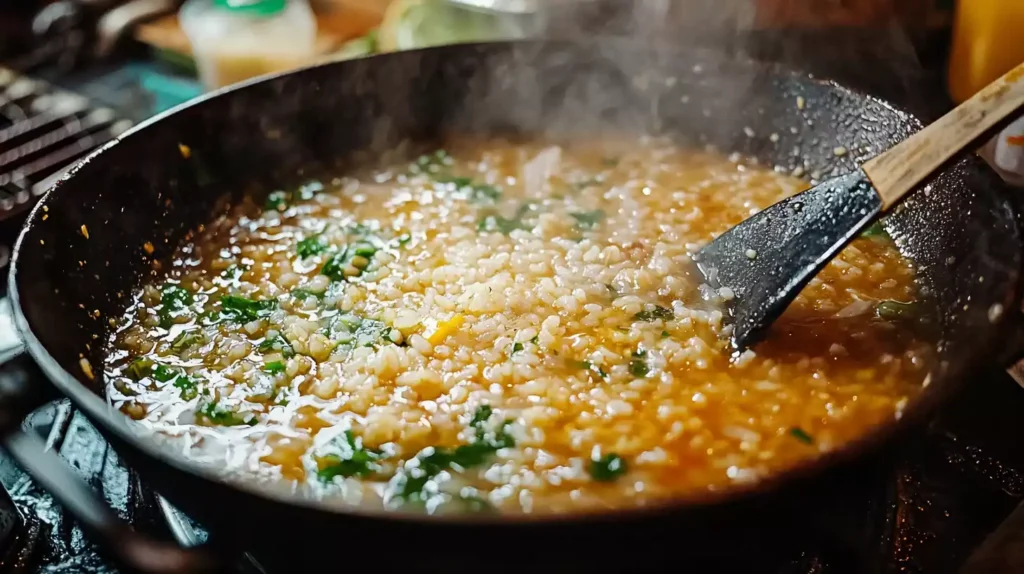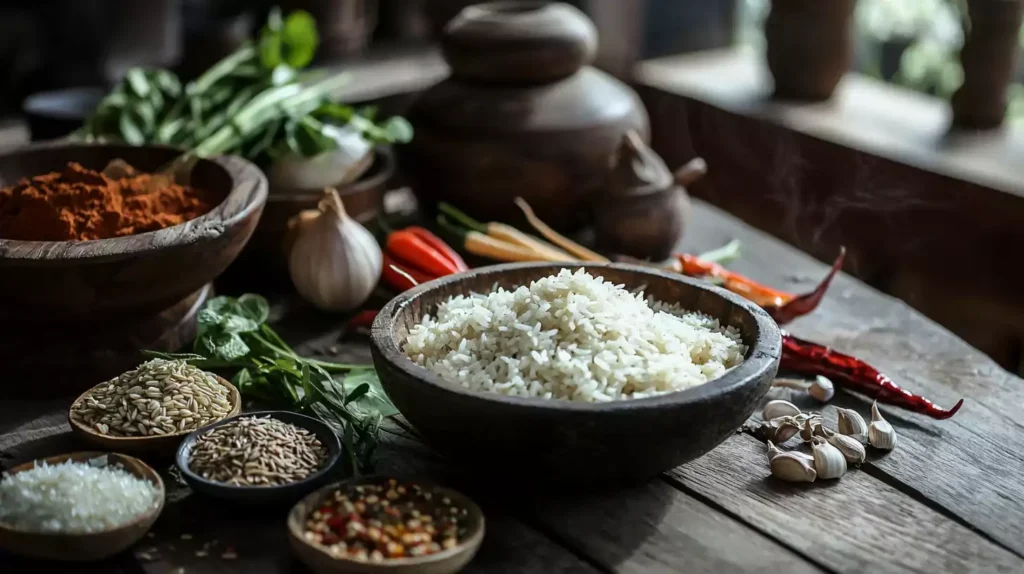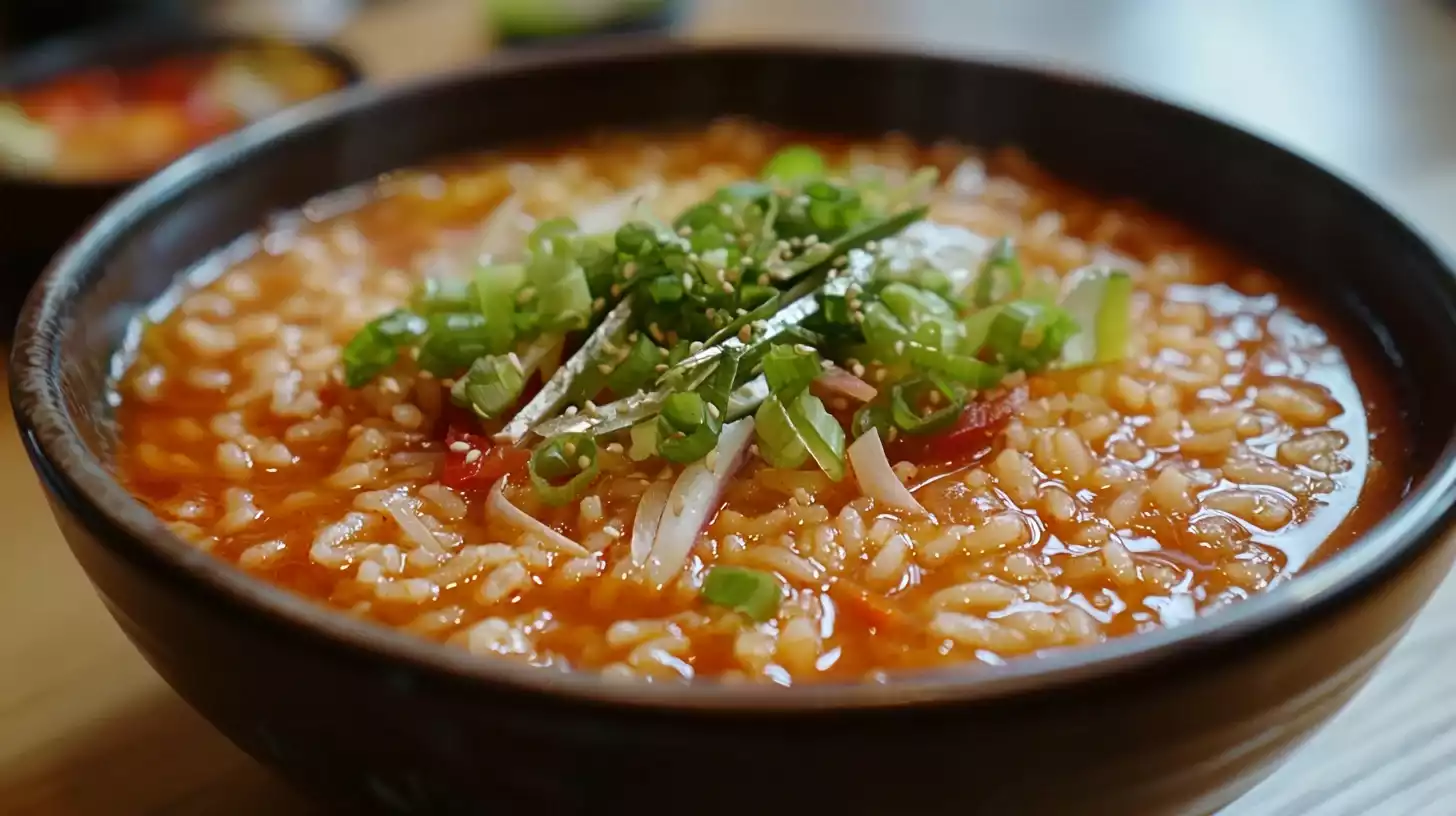Have you ever wondered, “Can I add rice directly to soup?” Many home cooks ponder this question, dreaming of a simple one-pot meal that’s both comforting and flavorful. Adding rice directly to your soup can be a game-changer, but it also comes with its own set of potential problems, like mushy grains or uneven cooking. If done correctly, this technique can result in delicious and time-saving results.
This guide will take you through everything you need to know, from choosing the right rice to mastering the cooking process, so you can achieve the perfect rice soup every time. This article provides you all the essential tips and tricks you need to make amazing soup at home. By understanding the question, “Can I add rice directly to soup?” you can elevate your cooking experience.

Table of Contents
In this article, we will explore the answer to the question, “Can I add rice directly to soup?” not only by providing tips but also by discussing the best practices for achieving delicious results. Whether you are making chicken soup or a veggie broth, knowing how to add rice can enhance the dish.
Understanding the Basics of Adding Rice to Soup
When contemplating, “Can I add rice directly to soup?” it is important to consider the type of rice you use, as not all varieties yield the same results. The right choice can make your soup delightful.
Adding rice directly to soup is a convenient and efficient way to prepare a meal, particularly when you want a hearty one-pot dish. It allows the rice to absorb the delicious flavors of the broth and other ingredients as they cook together, creating a harmonious blend of textures and tastes. However, this method isn’t without its challenges. You need to consider the rice variety you are using, cooking time, and proper liquid-to-rice ratios, to avoid the rice from becoming mushy. In some cases, precooked rice may be preferred in some cases for convenience and avoiding mushiness.
The appeal of adding rice directly to soup lies mainly in its convenience and efficiency. When you ponder the question, “Can I add rice directly to soup?” remember that it means you can cook your rice and soup all at once.
The Appeal of Adding Rice Directly
Furthermore, if you ever wondered, “Can I add rice directly to soup?” know that this method infuses the rice with the broth’s flavors, creating a more delicious dish.
Understanding the appropriate rice types for your dish is essential when you ask yourself, “Can I add rice directly to soup?” Selecting the right ingredients will help you achieve a comforting meal.
The appeal of adding rice directly to soup lies mainly in its convenience and efficiency. It means that you can cook your rice and soup all at once, cutting down on prep time and extra dishes. This method also infuses the rice with the broth’s flavors as it cooks, creating a more delicious and cohesive dish. This is a great way to cook rice if you want it to absorb all the delicious flavor of the soup. It also simplifies the cooking process, making it a perfect option for busy weeknight meals, and also ensures there are less dishes to clean up afterwards, which is always a bonus for everyone.
The Challenges of Direct Addition
When you contemplate the question, “Can I add rice directly to soup?” you must also think about the cooking time and how different rice types affect your dish.
Despite its advantages, adding rice directly to soup presents some notable challenges. The main concern is often the texture of the rice. When cooked directly in liquid, certain types of rice can become mushy, or too starchy, which can ruin the overall texture of the soup. Controlling the liquid ratio is also critical since the rice absorbs a significant amount of liquid as it cooks. This can lead to your soup becoming too thick or the rice not cooking correctly. Understanding these challenges is key to making sure you can get perfect results every time when making soups with rice.
Can I add rice directly to soup?
While there are challenges to cooking rice directly in soup, such as texture and timing, the benefits of adding rice directly to your soup are undeniable. When considering, “Can I add rice directly to soup?” remember that one major advantage is the flavor absorption.
In the context of your cooking, “Can I add rice directly to soup?” becomes a crucial consideration, especially when selecting rice that complements the ingredients in your soup.
Understanding the impact of various rice types on your soup is essential when you ask, “Can I add rice directly to soup?” The right rice will maintain its texture and flavor.
This flavor infusion is a delightful experience that can only be achieved when you ask, “Can I add rice directly to soup?” Cooking the rice with the soup can also save you time, making your meal preparation smoother.
Choosing the Right Rice for Your Soup

Selecting the right type of rice is crucial when planning to add it directly to your soup. Not all varieties are created equal. Some tend to become mushy while others hold their shape, some have a subtle flavor and others bring distinctive aromas to the plate. When you decide to cook rice directly into the soup, you must always pay attention to selecting the right grain, since this selection will ultimately influence the texture and the overall result of your soup.
Best Rice Varieties for Direct Addition
For the best results when adding rice directly to soup, choose varieties known for holding their shape and not becoming mushy when cooked in liquid. Long-grain rice is a great choice because it is lower in starch and tends to cook up separate and fluffy. Parboiled rice, which has been partially precooked, is also an excellent option since it is less likely to overcook. Basmati rice, with its distinctive flavor and aroma, is another good choice. All of these types of rice tend to hold their texture well and are suitable for soup preparation.
Rice Varieties to Avoid
There are certain rice varieties that you should generally avoid when cooking directly in soup. Short-grain rice, commonly used for sushi, is very starchy and will likely result in a mushy, gluey texture. This is due to the high starch content that is released during cooking. It is not suitable for soup. Arborio rice, often used in risotto, is another variety that will result in a creamy texture when it releases its starch during the cooking process. While great for certain dishes, they are not ideal when cooking rice directly into your soup because of their high starch content.
How Different Rice Types Affect Your Soup
The type of rice you choose for your soup has a major impact on the final result. Long-grain rice, for example, will maintain its distinct grains, offering a satisfying texture in every spoonful. Parboiled rice tends to be more forgiving and remains intact even after extended cooking time. Basmati rice, on the other hand, will infuse the soup with its unique aroma and subtle flavor, elevating the overall taste.
The texture of your soup will greatly depend on the type of rice you decide to use, making this a critical step in preparing delicious and perfectly textured rice soups. If you are looking for a great alternative, consider trying this delicious tomato soup, paired with rice on the side. This will ensure you will have delicious results every time you cook.
Step-by-Step Guide: Adding Rice Directly to Soup
Adding rice directly to soup is a skill that involves a few simple steps that will help you get perfect results if done right. From preparing your soup base to cooking your rice in the right timing, each step plays a major role in the result you want to achieve. By focusing on each step you will be able to master this cooking technique every time and avoid common problems that some people encounter.

Preparing the Soup Base
Before adding rice, the key is to prepare the soup base correctly. Make sure you have all the ingredients for your soup base and allow it to simmer. This could include broth, vegetables, and proteins. Ensure that you have the correct amount of liquid in the pot to accommodate for the rice’s absorption. When you have the right amount of liquid and your ingredients are ready, it is time to add the rice. This step ensures that the rice will cook evenly and absorb all of the flavors while cooking directly in the broth.
The Timing of Rice Addition
The most important step is to make sure you add the rice at the right time. You should add the rice when the soup base is simmering but before it is fully cooked. If you add it too soon, the rice may overcook and become mushy. Generally, adding the rice about 20-25 minutes before the soup is done is perfect. This timing ensures that the rice cooks properly, absorbing the flavors of the soup without turning mushy. It is also a great time to consider adding a pinch of salt, since it helps enhance the overall flavor of your dish.
Simmering for Perfect Results
As you enjoy your rice soup, reflect on the journey of asking, “Can I add rice directly to soup?” and how it has transformed your cooking skills into achieving perfect results.
Once the rice is added, turn the heat down to low and allow the soup to simmer gently. It is very important to avoid high heat, as this will cause the rice to cook too rapidly and can result in uneven cooking. The simmering process helps the rice absorb the soup’s flavor gradually, while also maintaining its texture. Cover the pot and let it simmer until the rice is cooked and tender, which should take about 15-20 minutes, but it can vary depending on the type of rice you use.
Checking for Doneness
To make sure your rice is perfectly cooked, you should remember to check for doneness. The question, “Can I add rice directly to soup?” should always lead you to ensure the rice is tender and fully cooked but still slightly firm.
Tips for Preventing Mushy Rice in Soup
One of the most common issues that arises when cooking rice in soup is that the rice can become mushy. However, there are steps that you can take to prevent this, starting with selecting the correct type of rice, the liquid content, proper cooking times, and avoiding excessive stirring. With these steps, you can master the process of cooking the perfect rice soup.
Controlling the Liquid Content
The right liquid content is key to prevent mushy rice. The ratio of liquid to rice is important since the rice absorbs the liquid while it cooks. Too much liquid can cause the rice to overcook and become mushy, while too little can result in undercooked rice. You should always follow your recipe instructions, but a good starting point is to use a 2:1 ratio of liquid to rice.
It is always a good idea to start with less liquid and add more as needed to avoid mushy results. It’s also important to keep in mind that different types of rice will absorb the liquid in a different way. This means that this proportion will vary depending on the type of grain that you use.
The Role of Cooking Time
The amount of time you cook the rice is critical when trying to avoid it from becoming mushy. Overcooking rice will make it turn soft, while undercooking it will make it still crunchy. Follow cooking guidelines, and always check your rice often so that you ensure that it reaches the perfect point. Start by checking on the rice after 15 minutes of simmering. It is always better to check on the rice often to ensure you will have the perfect result.
The Importance of Stirring
While it is important to stir sometimes, it’s very important to avoid doing too much stirring since that might result in mushy rice. Constant stirring will release the starch in the rice, resulting in an undesirable gluey and mushy consistency. After adding the rice, stir gently to prevent it from sticking to the bottom of the pot and then reduce the amount of stirring. A gentle stir is important to ensure that the rice doesn’t stick, while also ensuring that you avoid the dreaded mushy texture.
What to do if the soup is too thin or too thick?
Adjusting the soup’s consistency is a normal step in the cooking process. If the soup is too thin, you can continue to let it simmer uncovered for a few more minutes, allowing some of the liquid to evaporate. If the soup is too thick, you can simply add a bit more broth or water until you achieve the perfect consistency. It is important to add it gradually. You can add a tablespoon or two at the time, and stir, repeating until you reach your preferred consistency. With these adjustments you can achieve the perfect soup texture every single time you cook.
Serving and Storing Your Rice Soup
Once your rice soup is cooked, it’s time to enjoy it. Proper serving suggestions are key to make sure your presentation is on point. If you have some leftovers, knowing how to store it will ensure that it remains fresh and tasty. With proper storing techniques, you can enjoy it even on another day.
Ideal Serving Suggestions
For ideal serving, ladle the hot soup into bowls, and garnish with some fresh herbs, such as parsley or cilantro. You can also add some toasted sesame seeds for a nutty touch. A small slice of lemon can also add brightness to the dish. The presentation is very important, especially when you want to impress your guests. Serving your soup with a side of crusty bread will also greatly enhance the overall experience, creating a comforting and complete meal.
Storage Tips for Leftover Soup
To keep your soup fresh and tasty for later, allow it to cool down before transferring it to an airtight container. Be sure to store it in the refrigerator within two hours of cooking to prevent bacterial growth. Properly stored soup can last for up to three days. Storing your soup correctly helps maintain its quality and prevent food poisoning and will guarantee that your soup will still taste great when you decide to reheat it. If you have made a large batch of soup, you can also freeze it in portions, making it ideal for future meals.
Reheating Leftover Rice Soup
When reheating, you can do it in the microwave or in a pot on the stovetop. If your soup has thickened too much, add a splash of hot water, or a bit of broth while you reheat it. Heat it gently to prevent it from scorching. It is important to always monitor the soup while reheating, specially when doing it on the stove. Reheating the soup correctly will maintain its flavor and consistency, ensuring that it’s just as delicious as it was on the day you first cooked it.
Frequently Asked Questions (FAQs)
How do you keep rice from getting mushy in soup?
Keeping rice from getting mushy is mainly about using the right type of rice, not overcooking it, using the correct ratio of liquid, and avoiding excessive stirring. Always choose long-grain or parboiled rice since they are less likely to release excess starch when cooked in a liquid. Make sure you measure the liquid carefully and don’t stir too much. Always add the rice in the last 20-25 minutes of cooking, or just before the soup is finished. By following these tips, you will be able to avoid the mushy consistency that is a common problem.
Do you cook the chicken before putting it in soup?
You don’t need to cook the chicken before putting it in soup, but it all depends on the result you are looking for. Adding raw chicken directly to the soup will give it a richer flavor, but you will have to make sure that it is fully cooked and safe to eat before serving.
You can also add precooked chicken to your soup which is a great option if you are looking to save time. If you are adding it precooked, you should add it at the end of the cooking process to make sure that it doesn’t dry up, which is also a common problem. If you want a more flavorful broth, adding raw chicken at the beginning is the best option.
How to thicken up chicken and rice soup?
If your chicken and rice soup is too thin, there are several ways to thicken it up to achieve the desired consistency. You can simply continue to simmer it uncovered for a few minutes, which allows the liquid to evaporate. Another effective option is to use a thickening agent, like a mix of flour and water or cornstarch with water, which should be added in small amounts until you reach your desired consistency.
Another option is to add an egg yolk to the mix to help thicken it, but you must use low heat to prevent it from scrambling. When adding a thickening agent it is important to allow the soup to simmer gently, stirring until it thickens to the perfect consistency.
Conclusion
Adding rice directly to soup can be a game-changer for your cooking routine when done correctly. By selecting the right type of rice, using the correct liquid ratios, and mastering cooking times, you can achieve a delicious and satisfying one-pot meal that will please your family and your friends. With the right techniques, you can easily avoid mushy rice and create a dish that is both comforting and flavorful. So, go ahead and try adding rice directly to soup and you will see that it will be an amazing culinary experience, and you can achieve the perfect result every single time.
For More Articles Links:

